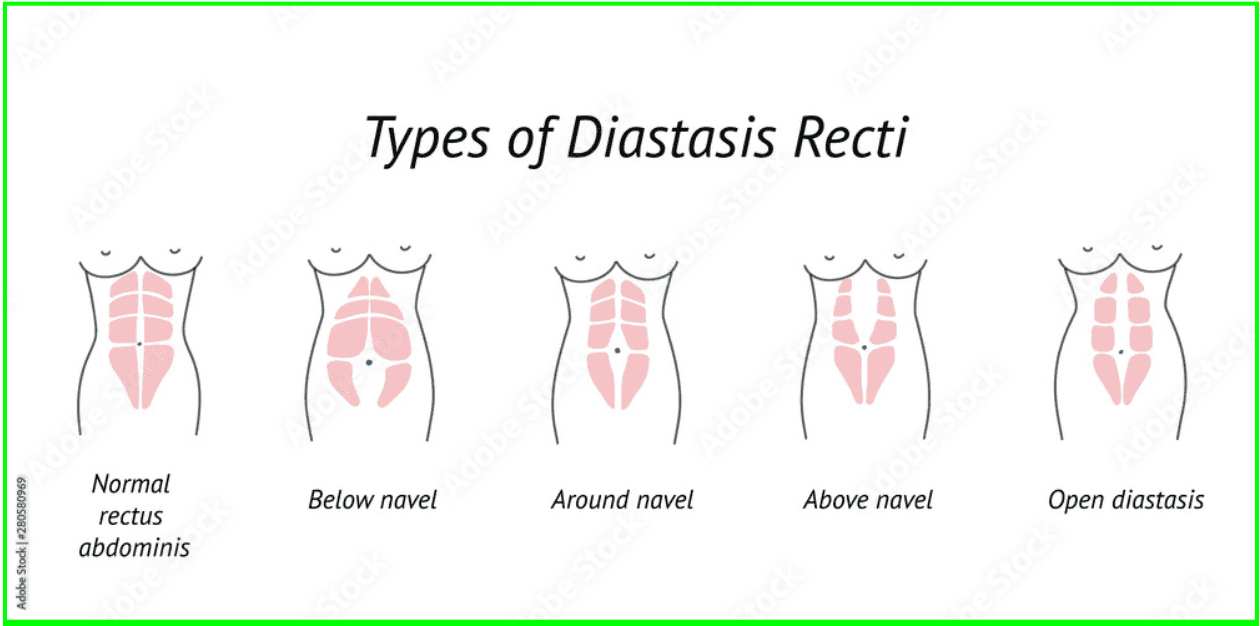Hey there, Moms! It’s time to talk about a topic that might not be as glamorous as baby snuggles and first steps but is just as important: diastasis recti!
So, what exactly is diastasis recti? During pregnancy, as your belly grows to accommodate your baby, the linea alba (the tissue that connects your abdominal muscles and makes up the vertical line of visible abs) can stretch and weaken. The pressure exerted by your growing uterus pushes out on the weakened tissue causing a gap between the muscle bellies of the “6 pack” muscle. This separation is what we call diastasis recti.

Now, don’t panic! Diastasis recti is incredibly common among moms. About one third of diastasis will resolve on its own postpartum, which is fantastic, but still leaves two thirds of women still dealing with a diastasis recti long term! It’s not something to be ashamed of; it’s a natural part of the miraculous journey your body goes through to bring life into this world.
You might be thinking, “Okay, but how does this affect my life?” Diastasis recti can manifest in various ways! Besides the classic “mommy pooch” that refuses to budge despite your best efforts with diet and exercise, you might experience lower back pain, poor posture, or even difficulty with activities like lifting your kiddos, carrying groceries, or getting out of bed. Some people even describe it like their “core is not ‘on’ anymore”.
So, how do you know if you have diastasis recti? Here are a few telltale signs:
- A visible bulge or ridge along your midline when you engage your core
- Lower back pain
- A persistent pooch that doesn’t shrink with diet and exercise
- Urinary leakage when you laugh, sneeze, or pick up your child
- Wider rib cage postpartum (bra is not fitting like it did pre-kids)
- Difficulty with returning to exercises you liked to do pre-kids
So.. what can we do about it? There are ways to manage diastasis recti and regain your core strength. First off, mastering breathing mechanics and intra-abdominal pressure control is key. The only thing that can make your diastasis worse is by putting pressure on it. Because of this, it is crucial to learn to breathe during exercises or daily activities to avoid increasing the strain on the weak part of your abdomen. For example, if you notice a big outward pooch when doing something like a plank, your body is telling you that demand on those muscles exceeds what the muscle is capable of. When something is too hard for the muscles, our body will find a way to compensate, which in this case looks like increasing abdominal pressure. When we have a weak spot in the abdomen, the pressure will take the point of least resistance and push outwards, which can widen the gap of your diastasis. The easiest way to fix this is to make a different point of least resistance- your mouth! Learning to exhale rather than holding your breath can make a world of difference. It is also vital to choose core strengthening activities that are not too demanding of the core’s current ability to fire. Meet yourself where you are at!
Here’s where pelvic floor physical therapists come to the rescue! A skilled physical therapist can assess your diastasis recti and create a personalized treatment plan to help you strengthen your core safely and effectively. They’ll teach you exercises and techniques to close the gap, improve posture, improve hip strength, and prevent further complications down the road. Moral of the story… this is not something that you have to just live with now that you are in your postpartum era. More importantly, the longer you let this linger, the more issues you can layer on down the road, like back pain, hip pain, and much more leaving you to seek other treatments like injections or surgery. Pelvic floor physical therapy is the crucial first step in managing your diastasis recti early so you can avoid these issues in the future.
Remember, diastasis recti is just one chapter in your amazing journey of motherhood. Embrace your body, celebrate its resilience, and don’t hesitate to seek support when you need it. With patience, perseverance, and the right coaching you’ll reclaim your core strength and rock that mommy belly like the supermom you truly are!
If you’d like to talk to a specialist to find out if pelvic floor physical therapy is right for you, call or text us at 973-310-2678. Or email us at info@bodymoksha.com for more information on how we can help.
Author:
Dr. Leah Connerty, PT, DPT, PCES
Doctor of Physical Therapy
Postpartum Corrective Exercise Specialist

